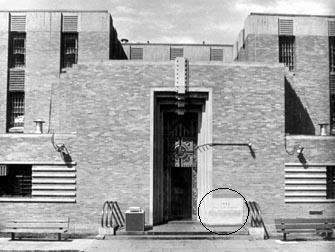![[JATC cornerstone]](cornrst3.jpg) |
|
The words "Hon. Richard C. Patterson Jr. Commissioner of Correction" appear immediately below Mayor Jimmy Walker's name and title on the 1933-dated cornerstone of what is now known as James A. Thomas Center but was then the Rikers Island Penitentiary. The last two lines identify the architects. |
Rikers Island
Penitentiary
Cornerstone
'Inside Story'
More than a few of the tens of thousands of NYC Department of Correction staffers who have worked in or near the former Rikers Island Penitentiary since it opened nearly three-quarters of a century ago have noticed the building entrance cornerstone at one time or another.Some may have wondered what mementos had been ceremonially cemented inside it. Here's that "inside story."
The main item enclosed within the marble block is a message to future Correctional personnel, including those presently serving in that capacity:
To Those Who Come After Us:
Those who are laying this cornerstoner today do so with mingled feelings of humility and hope;
--- humility because of the realization of the multitude of threads of heredity, environment, education, association and mental and physical and emotional equipment which go to form the fabric of the offender;
--- and hope that the treatment which these unfortunates will receive in this institution will be the means of salvaging some lives which would otherwise have been wasted.
You who open this cornerstone in the years to come may, in the light of new discoveries in the sciences of human behavior, smile at what may be looked upon as our feeble efforts to solve a problem which up until now has existed since the world began.
If so, we hope your criticism will be tempered by the thought that we did the best we knew how in the light of such knowledge and understanding as was given us.
That your knowledge and understanding may be infinitely greater is the wish of those who are today laying this cornerstone.
JAMES J. WALKER, Mayor.
RICHARD C. PATTERSON, Commissioner.
Dr. EDWARD C. BRENNER, President, Medical Board.
ROBERT APPLETON, President, Association of Grand Jurors.
E. R. CASS, General Secretary, Prison Association of New York; ex-president, American Prison Association.
ROBERT L. TUDOR, First Deputy Commissioner.
ISAAC GOLDBERG, Second Deputy Commissioner.
JOSEPH F. FISHMAN, Third Deputy Commissioner.
|
Other Items Inside Cornerstone
Among other materials sealed in the cornerstone with the above message were:
- A copy of the printed program for the July 28, 1931 cornerstone ceremonies. The program includes a list of the major organizations that helped bring about the then new penitentiary;
- Copies of the major daily newspapers that circulated in the city in that era, many of which are now defunct.
- A copy of the Panel, a publication of the Association of Grand Jurors.
- A copy of the Department of Correction's 1930 annual report; and
- Various coins in common circulation in 1931.
 | The building front of the James A. Thomas Center still displays the original Rikers Island Penitentiary cornerstone, circled here in an early photo and shown enlarged above. |
The cornerstone measures 59 inches in width and 44 inches in height. Its depth is not available for measiuring because much (if not most) of that is covered by overlays of other stonework that help frame the entrance.
The New York Times of July 29, 1931 reported on the cornerstone-laying ceremonies for the new penitentiary then scheduled to cost $9 million and to open in 1933 as a replacement for the old penitentiary on Welfare Island (now Roosevelt Island).
Note that by the time the transfer of the old penitentiary's inmate population to the new facility on Rikers Island had been completed Feb. 7, 1936, the cost of construction had risen to $12 million.
Thus the "1933" chiseled into the marble block marks not the date the stone was laid, nor the date the construction was actually completed, but only the target date it had been expected to be completed.
Commissioner Patterson, according to the Times 1931 story about the cornerstone ceremonies, said that, when the facility opened, all newly arriving inmate would spend at least 30 days in a "receiving building" being examined by psychiatrists, psychologists and doctors; would receive attention of a social services bureau, have access to library, opportunity to attend school, exercise, learn a trade, etc.
He declared the new institution was "designed to return the prisoner to society better than when he entered it, not worse, as is the case today." Those remarks were consistent with the message encased in the cornerstone. Both reflected a faith (more widely and deeply held back then than today) in the ability of "the sciences of human behavior" to "solve a problem which up until now has existed since the world began" -- that is, the problem of crime and its perpetrators.
|
